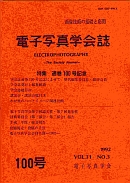Volume 34, Issue 3
Displaying 1-13 of 13 articles from this issue
- |<
- <
- 1
- >
- >|
Original Articles
-
1995Volume 34Issue 3 Pages 160-166
Published: 1995
Released on J-STAGE: April 06, 2007
Download PDF (1165K) -
1995Volume 34Issue 3 Pages 167-172
Published: 1995
Released on J-STAGE: April 06, 2007
Download PDF (1656K) -
1995Volume 34Issue 3 Pages 173-180
Published: 1995
Released on J-STAGE: April 06, 2007
Download PDF (1758K) -
1995Volume 34Issue 3 Pages 181-189
Published: 1995
Released on J-STAGE: April 06, 2007
Download PDF (2792K) -
1995Volume 34Issue 3 Pages 190-199
Published: 1995
Released on J-STAGE: April 06, 2007
Download PDF (1142K) -
1995Volume 34Issue 3 Pages 200-207
Published: 1995
Released on J-STAGE: April 06, 2007
Download PDF (1131K)
Technical Review
-
1995Volume 34Issue 3 Pages 208-212
Published: 1995
Released on J-STAGE: April 06, 2007
Download PDF (1033K)
Imaging Today
“Recent Advances in Color-Ink-Jet Printer”
“Recent Advances in Color-Ink-Jet Printer”
-
1995Volume 34Issue 3 Pages 214-220
Published: 1995
Released on J-STAGE: April 06, 2007
Download PDF (1782K) -
1995Volume 34Issue 3 Pages 221-225
Published: 1995
Released on J-STAGE: April 06, 2007
Download PDF (1285K) -
1995Volume 34Issue 3 Pages 226-228
Published: 1995
Released on J-STAGE: April 06, 2007
Download PDF (1016K) -
1995Volume 34Issue 3 Pages 229-233
Published: 1995
Released on J-STAGE: April 06, 2007
Download PDF (886K) -
1995Volume 34Issue 3 Pages 234-238
Published: 1995
Released on J-STAGE: April 06, 2007
Download PDF (712K) -
1995Volume 34Issue 3 Pages 239-242
Published: 1995
Released on J-STAGE: April 06, 2007
Download PDF (517K)
- |<
- <
- 1
- >
- >|
